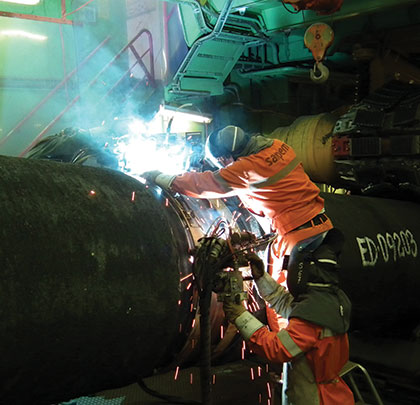Trained pipefitters and welders come across opportunities to work on offshore oilrigs across U.S. waters and around the globe. They are responsible for ensuring that machinery and pumps continue to operate effectively. In addition to traveling to the offshore work-site, these professionals receive a high level of compensation, a flexible work schedule, and plenty of recreational activities to stay active while at sea.
WHAT IS OFFSHORE PUMPING AND WELDING?
Every facet of an offshore oilrig revolves around a synchronous movement to pull oil from beneath the ocean floor. This task comes with a caveat: salt water is corrosive to metal. As a result, the pipes, including those above water, have a tendency to weaken and must be consistently repaired throughout the course of operation. An offshore pumping professional or welder will be responsible for ensuring the pipes maintain their purpose while watching over the stability of the structure of the rig itself. If you would like to weld beneath the waves, you will need a diving certification in addition to your welding training.
WHAT ARE the CAREER PROSPECTS?
According to the Offshore Welding Jobs website, entry-level welders often start out making between $66,000 and $80,000 per year. The decline in oil prices in 2014 have led to many oilrigs freezing their hiring for the first quarter of 2015. However, oil refineries have transitioned to producing summer-blends of oil products, and offshore oilrigs will need to produce larger quantities of crude oil to meet this demand. In addition, Tulsa Welding School reports that the industry is desperately seeking skilled pipeline workers, as a large portion of the current workforce is set to retire in the upcoming years. Current offshore programs will be difficult to complete without the adequate personnel. This demand for young talent will likely not be met soon.
WHAT IS THE WORK SCHEDULE LIKE?
Since offshore welders travel to and from the rig to land by way of helicopter or boat, they typically work on a rotation schedule. Many offshore pumping professionals work two to four weeks at the rig and then have a two- to four-week time period off. However, each oil company may have its own schedule, and you may be able to have longer lengths at sea if you prefer. Depending on the need to bring new oilrigs on line, you may be sent to multiple rigs for several days, rather than weeks, before having a few days off.
WHAT CAN YOU DO IN YOUR SPARE TIME AT SEA?
When you think about working on an oilrig, far from the entertainment and variety you would find on land, you probably associate solitude and boredom with the job. Yet, in reality, you will have many different recreational opportunities. Modern oilrigs often have advanced living quarters, outdoor sporting courts, movie rooms, and Internet access, keeping you active and entertained during your off-hours. Moreover, with Internet access you will be able to stay in contact with your family and friends while at sea.
As the demand for energy continues to grow, more trained pumping professionals will be needed to maintain and operate offshore drilling sites throughout 2015 and beyond. Because of its lucrative pay, flexible schedule, short training required, and recreational opportunities, a career on an offshore drilling rig is one of the most promising career opportunities for skilled professional pumping specialists in 2015. ■
About The Author
Monica Gomez writes on professional issues facing the upstream pumping and oil processing markets. She can be reached at gomezmonica53@gmail.com.
MODERN PUMPING TODAY, March 2015
Did you enjoy this article?
Subscribe to the FREE Digital Edition of Modern Pumping Today Magazine!


